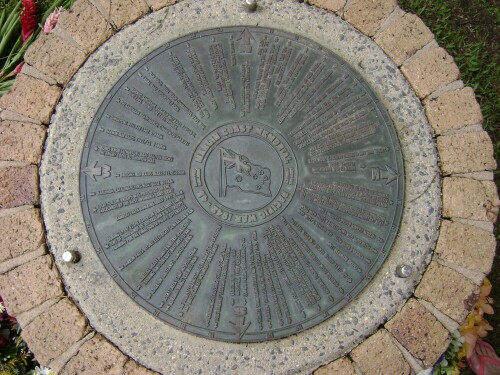
|
x x Written by Gordon McKauge ... Trinity Beach Monday 25th April 2005 |

|
x x Written by Gordon McKauge ... Trinity Beach Monday 25th April 2005 |
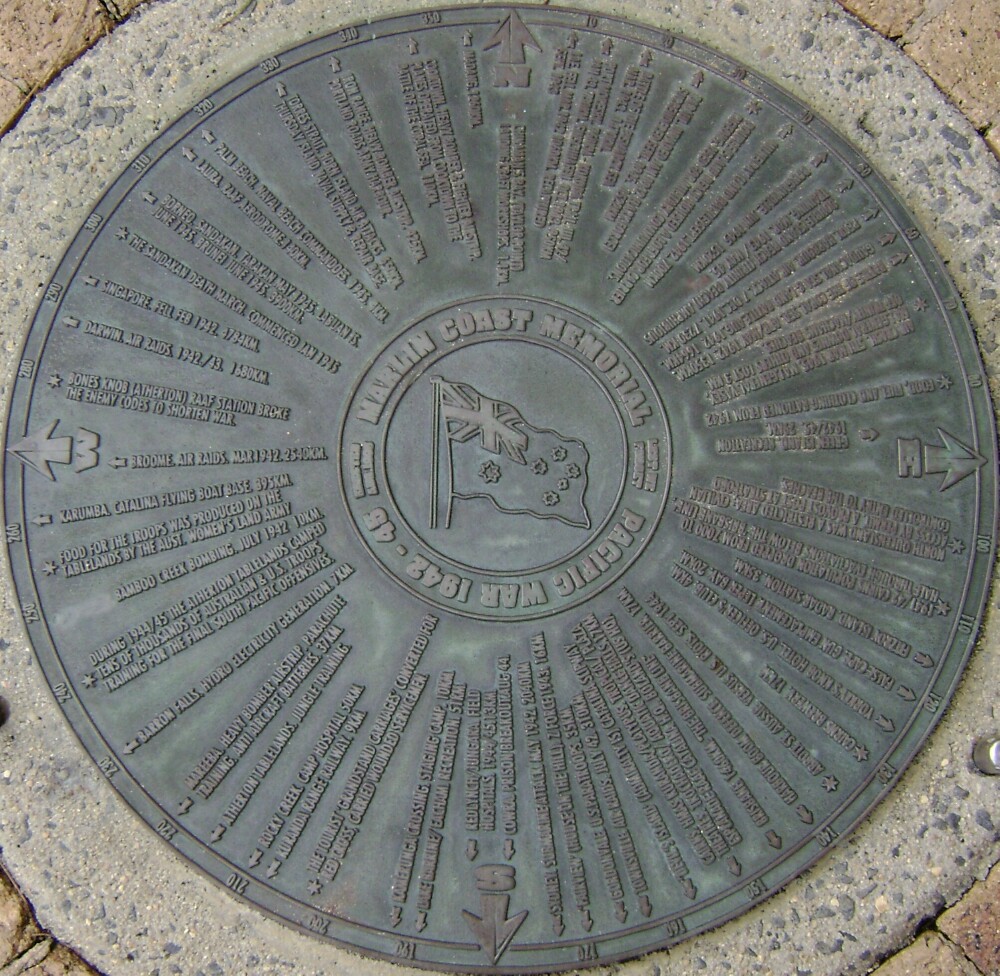
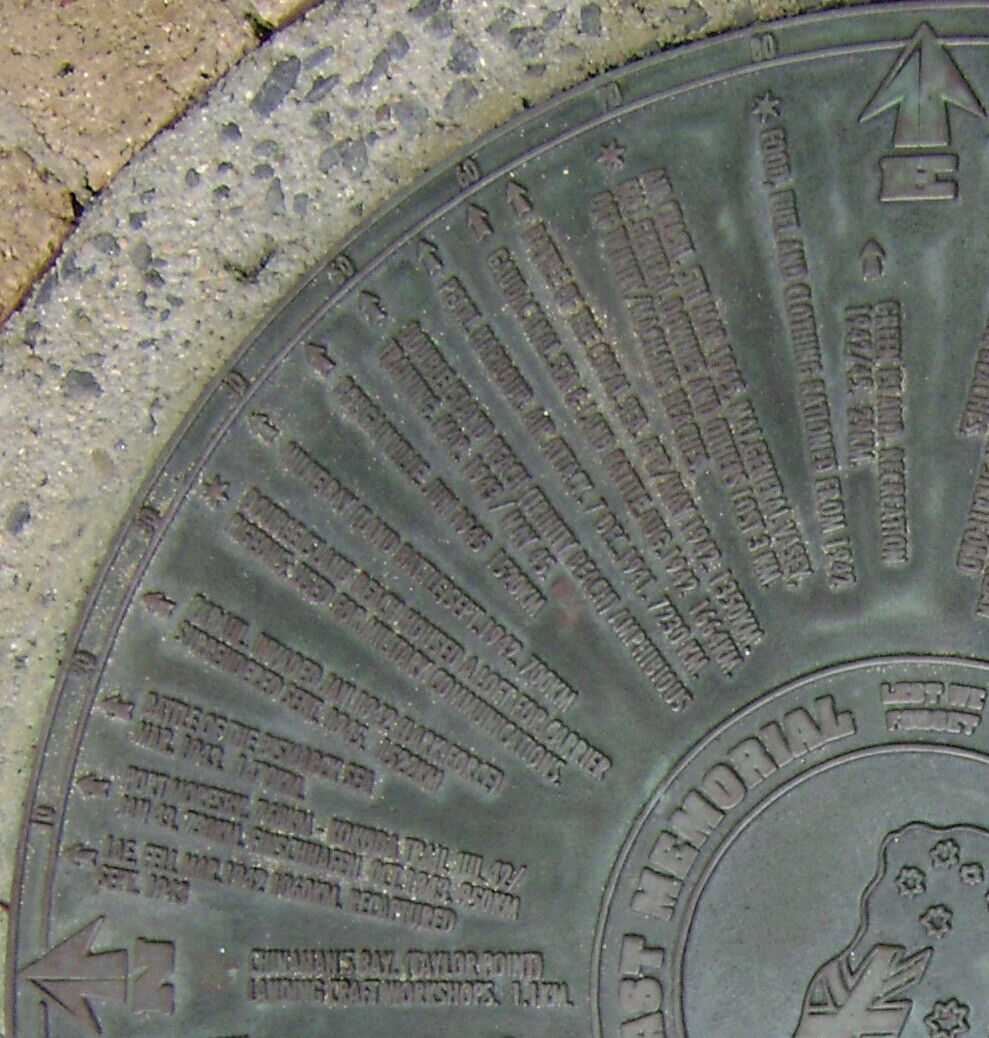
|
NORTH CHINAMAN'S BAY TAYLOR POINT LANDING CRAFT WORKSHOPS 1.1KM Less than one kilometre from here, this was the home of the Army Water Transport ... you can still sit on the remains of the foundations of their huts, some of which were built out over the water ... one mess hut, located further back from the beach, was used right up to the 1990's as a Girl Guide camp until the church, to whom it was bequeathed, sold the property, and the building was torn down ... great shame ... the barges were crewed by tank crews who became redundant when it was discovered that our tanks were unsuitable for the jungles and were returned to Australia ... a problem existed for about fifty years for local fishermen caused by the ‘arc mesh' that had been laid all over the bottom of the bay so amphibious vehicles driving ashore would not get bogged ... it has taken fifty years for it to rust away x x 8 EAST LAE FELL MAR 1942 1060KM RECAPTURED SEPT 1943 Lae was the scene of vicious fighting between the Japanese and Australian troops, and figures prominently in the history of the New Guinea campaign x x 13 EAST PORT MORESBY 760KM KOKODA TRACK JUL42/JAN43 FINCHHAFEN OCT 1943 950KM The Japanese wanted to take Port Moresby from the north, and they thought the Kokoda Track was a motor track over the ranges ... in reality, at that time it was a walking track, and no white man had traveled its full distance for twenty years ... the Japanese forces got to within twenty-five miles of Port Moresby and that put them about the same distance from Cairns as Rockhampton x x 18 EAST BATTLE OF THE BISMARK SEA MAR 1943 1470KM This involved the annihilation of a Japanese reinforcement convoy, prompting them never to try to reinforce their forces in East New Guinea again ... and an important turning point in the war x x 26 EAST RABUAL INVADED JAN 1942 (LARK FORCE) SURRENDERED SEPT 1945 1522KM A long story, but later in the war bombers operating from Cape York helped force the Japanese out of Rabual x x *** DOUBLE ISLAND BEACH HOUSED A LOFT FOR CARRIER PIGEONS USED FOR MILITARY COMMUNICATIONS The landing barges used by Water Transport, at Chinaman’s Bay, were not Htted with radios, and used carrier pigeons for keeping in touch with their bases in New Guinea later in the war ... legend has it that, if they forgot to send one back every evening`with a report, their final count would be wrong, and they would be censured ... they got around that problem by cooking and eating any surplus birds x x 40 EAST MILNE BAY (LAND BATTLE) SEPT 1942 700KM I recall calling at Milne Bay with my late father in a Naval Ship during the mid 50's while he was recruiting the first sailors for the PNG Navy ... it is renowned for it's very deep water, right up to the shoreline ... so deep, in fact, that ships could be unloaded there during the war without the need for wharves x x 46 EAST BOUGAINVILLE JUN 1945 1520KM x x 50 EAST DOUBLE ISLAND BEACH (TRINITY BEACH) AMPHIBIOUS TRAINING MAR43/MAY45 Whilst amphibious training was carried out on several Marlin Coast beaches from 1943 onwards, the main activity occurred here at Trinity during late 1944 and early 1945 to prepare for the invasion of Borneo ... many tens of thousands of Australian troops were assembled in this area, and on the Atherton Tablelands, to prepare for this operation x x 56 EAST PEARL HARBOUR AIR ATTACK 7 DEC 1941 7230KM Australia was already under threat at this time, and if the US hadn’t been drawn into the war by the Pearl Harbour attack, we would have been quickly overrun ... the Government called for voluntary evacuation in January 1942, and about half the population of Cairns sold up and moved south or to the Tablelands ... it didn’t take long for the Japanese to get down near here, attacking the airstrip on Horn Island, near Thursday Island, in March 1942 x x 59 EAST GUADACANAL SEA & LAND BATTLE AUG 1942 1664KM The Japanese wanted the US Air Force Base in the Solomon Islands so they could reach Port Moresby and Australia with bombers x x 63 EAST BATTLE OF THE CORAL SEA APR/MAY 1942 1350KM This major sea encounter with principal ships sunk from both sides, was another turning point of the war ... legend has it that people in Mossman could see the gunfire and hear the explosions, but this is probably exaggerated ... some have theorised that freak atmospheric conditions might have made this possible x x *** AIR CRASH 5TH MAY 1945 MAJ GENERAL VASEY, MAJ GENERAL DOWNES AND OTHERS LOST 3KM OFF TRINITY / MACHANS BEACHES Twenty-three Army people were killed when their aircraft was coming in to land at Cairns on its way to New Guinea ... there was a cyclone with heavy rain and high winds when the aircraft went down, and the first rescue attempt was by a thirty foot workboat from the Water Transport base here at Chinaman's Bay ... with General Vasey was the Chief of the Army Medical Services, Major GeneraI Downes ... many dignitaries came to Cairns for the funeral and burial in the Martyn Street Cemetery including General Sir Thomas Blamey and General Sir Leslie Morehead, famous for his exploits at Gallipoli (click here for more details on the Air Crash ... and also ... click here for more details on Major General Vasey and Vasey Esplanade) x x *** FOOD, FUEL AND CLOTHING RATIONED FROM 1942 We all got used to rationing but food and materials were very short ... tobacco was rationed, so it was too valuable for kids to get hold of, and probably saved a lot of young lungs ... butter too, and it became a precious commodity, and as late as 1948, little squares were commonly used as bartering currency at boarding school x x 87 EAST GREEN ISLAND RECREATION 1942/45 29KM One Hayles launch a week used to deliver food to the six families that had permanent huts or camps on the island ... mainly to support older men who used their launches to patrol the Grafton Passage through the reef, looking for Japanese ships ... but dozens of barges used to run up onto the beach at weekends to provide a day out for troops and nurses and other services' personnel ... they sometimes had a rough crossing, being flat bottomed, and many passengers got very seasick ... it is thought that they delivered the first rats to the island, which eventually ate the bird's eggs and killed off the island bird population |
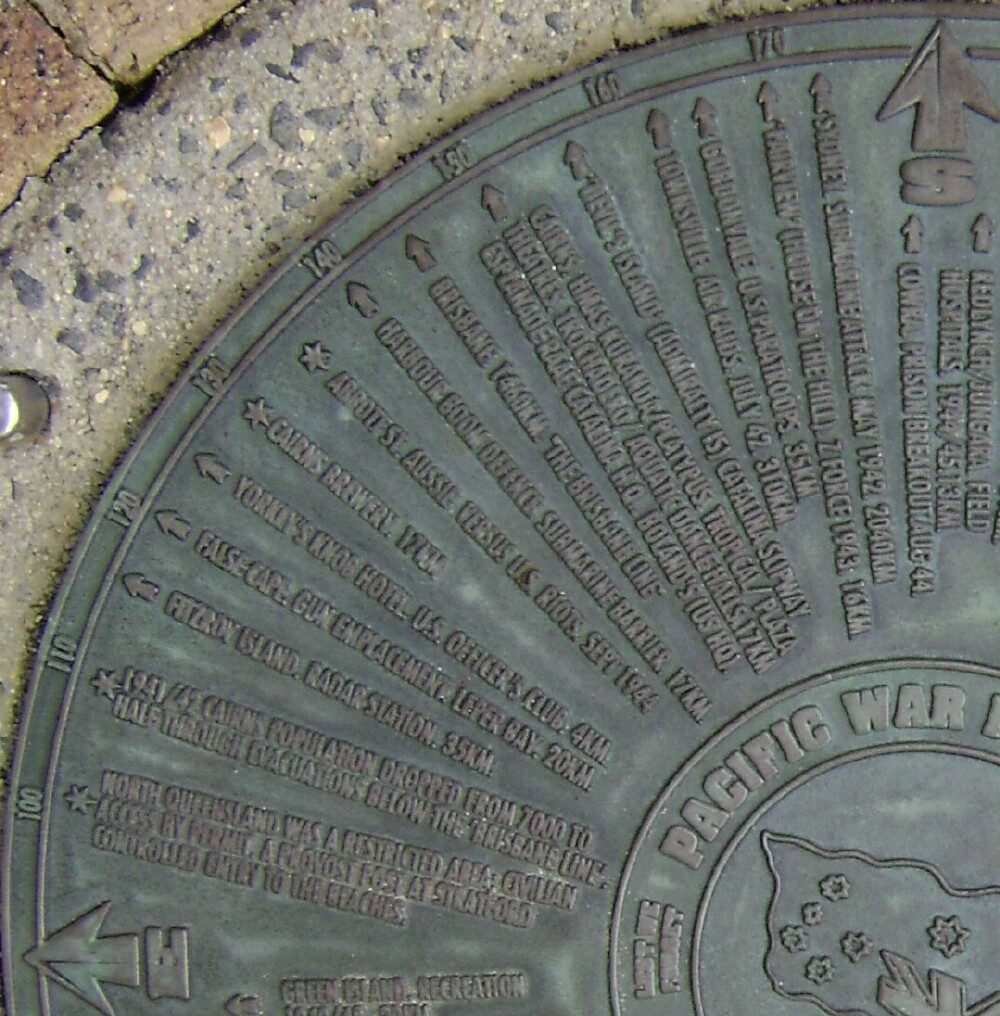
|
*** NORTH QUEENSLAND WAS A RESTRICTED AREA CIVILIAN ACCESS BY PERMIT A PROVOST POST AT STRATFORD CONTROLLED ENTRY TO THE BEACHES Everyone required a special Government permit to get into North Queensland from 1942 onwards, one was not needed to get out ... the checkpoint was at EI Arish ... Vera Bradley, in her book "I Didn't Know That", tells of one incident when a whole trainload of school children returning home from their boarding schools at Charters Towers were refused entry because they had no permits ... the train was held at EI Arish station until the Army contacted all the parents and had them obtain the necessary paperwork x x *** 1941/42 CAIRNS POPULATION DROPPED FROM 7000 TO HALF THROUGH EVACUATIONS BELOW THE 'BRISBANE LINE' x x 116 SOUTH FITZROY ISLAND RADAR STATION 35KM ln 1943, a primitive, manual radar station was built on Fitzroy Island by the RAAF ... it was manned by fourty personnel and the Navy had a 'Fairmile' patrol boat stationed there to intercept any enemy craft that were spotted ... the accommodation that was built was taken over by the lighthouse keeper after the war, and I recall many climbing adventures when, as children, we battled to the very top of the island’s peak to sit in the remains of the observation platform x x 121 SOUTH FALSE CAPE GUN EMPLACEMENT LEPER BAY 20KM Leper Bay was the original name for what is now known as Happy Bay ... it appears that, prior to the war, the State Government decided to round up all the lepers and house them in two isolated facilities, one on Palm Island near Townsville and one here at False Cape ... this is the southern point in the Cairns Inlet ... however, when it came time to round up the lepers, they only found enough to fill one facility so the False Cape unit was never occupied ... the Army installed two major 155mm defence guns there, which could fire on ships which might try to enter the harbour ... their very substantial concrete bunkers are still there and can be seen from tourist boats going out to the reef x x 126 SOUTH YORKEY’S KNOB HOTEL US OFFICERS CLUB 4KM Yes, there was a hotel at the northern end of Yorkey’s Knob from prior to the war to sometime in the 1950's ... during the war it was set up as a US Officers rest and convalescent home and was closed to the public when too many people were getting drunk and causing trouble ... it became a bit of a 'blood house' after the war and eventually burnt down, never to be rebuilt x x *** CAIRNS BREWERY 17KM The Cairns Brewery (the building still stands) was a major employer and supplied beer all over the north and west to Mt Isa ... it's draught beer was famous, due probably to the quality of the Cairns water supply ... until well after the war, there was no bottling plant so the hotels bottled their own beer from kegs and sometimes the cleanliness of the bottles was questionable x x *** ABBOTT ST AUSSIE VERSUS US RIOTS SEPT 1944 Tensions always did run high between the Yanks and the Aussies with a limited number of girls and a limited supply of beer to share, but it all came to a head when an incident started by an Australian soldier and some US Provo's started an all out riot in the main street ... truckloads of troops came into town, the Yanks from around Gordonvale and the Aussies from the Northem Beaches, and literally hundreds got into it ... many were injured, and it took days to quieten the town down ... legend has it that there was a machine gun mounted atop the post office to maintain order but I have had some trouble verifying this x x 140 SOUTH HARBOUR BOOM DEFENCE SUBMARlNE BARRIER 17KM It was a wire net structure attached to pipe frames, which were anchored to the bottom of the sea ... there was a barge at the corner about two-and-a-half miles out from the RSL then it ran across to Bessie Point ... a flexible mesh 'gate' could be opened from the barge with a winch ... the boom defence was supposed to stop Japanese submarines getting in to the wharves and shipping, and more particularly, the Catalina sea planes which operated from the inlet ... it was still there many years after the war, which was a nuisance, as boats had to go round it to get to the jetties and wharves from the Esplanade x x 146 SOUTH BRISBANE 1460KM "THE BRISBANE LlNE" The 'Brisbane Line' will always be a sore point with North Queenslanders ... it was a line of tank bases strung out west of Brisbane to defend Australia against a Japanese invasion ... the Government had no intention of trying to defend the rest of Queensland and if you hadn't already evacuated below the line, you were on your own x x 151 SOUTH CAIRNS HMAS KURANDA/PLATYPUS TROPICAL/PLAZA THEATRES TROCHADERO/AQUATIC DANCE HALLS 17KM ESPLANADE RAAF CATALINA HQ BOLAND'S (US HQ) HMAS Kuranda was a small Naval base located diagonally across from the now Pacihc Hotel ... for many years, the huts they left behind were used by various community groups such as the lifesavers ... there were two picture theatres operating, the Tropical and the Plaza, both in town ... the Rex, on Sheridan Street, was used by the Americans as a store ... the two dance halls did a roaring trade, the Aquatic being the Sailing Club, which is currently under threat ... there was a large group of huts built out over the sea from the Esplanade, where the Catalina Headquarters were located ... the historic department store, Bolands, was taken over as the US Army Headquarters x x 157 SOUTH "DEVIL'S ISLAND" (ADMIRALTY ISLAND) CATALINA SLIPWAY There were a lot of Catalina seaplanes stationed in Cairns, and the sandy slipway they used for maintenance is still to be seen on the northern end of Admiralty Island ... in those days, the Air Force called it Devil's Island ... not a bad name when you consider the mosquitoes and sand flies ... it was strictly illegal to throw rubbish into the inlet from boats or wharves, particularly bottles ... this was because a Catalina taking off or landing could rip a great hole in their hulls if they struck anything solid x x 163 SOUTH TOWNSVILLE AIR RAIDS JULY 1942 310KM These 'air raids' seem to have been halthearted affairs, and were probably more about reconnaissance x x 166 SOUTH GORDONVALE US PARATROOPS 35KM There were three-thousand-five-hundred American paratroopers stationed at Gordonvale during 1943 and many local women were employed packing their parachutes ... there were often fights in the town, not, surprisingly between the Yanks and the Aussies, but between the paratroopers and US Marines and others who would try to muzzle in on their limited pub beer supplies ... one very memorable incident was when there were many and varied reports of a large Japanese paratroop force landing in Gordonvale ... in fact, it was an American character who got drunk with a nurse and promised to organize a parachute jump for her the next morning at first light ... he found a plane, a couple of pilots, and an ambulance in case there was an accident, and pulled it off x x 170 SOUTH "FAIRVIEW" (HOUSE ON THE HILL) Z FORCE 1943 16KM The first Mayor of Cairns, Richard Kingsford, grandfather of Sir Charles Kingsford Smith, built this home on its hill ... but it became better known for housing the famous 'Z Force' which departed Cairns in the Krait in August 1943 for the raid on Singapore shipping ... during their training, the folboat crews often slept on these very beaches whilst preparing for their incredibly courageous task x x 173 SOUTH SYDNEY SUBMARINE ATTACK MAY 1942 2040KM The Japanese miniature submarine attack on Sydney Harbour, which sank several ships, is well documented ... but what is lesser known is the Japanese submarine activity here around Cairns ... two positive sightings were made at Green Island and Fitzroy Island at different times, and a group of Japanese sailors, walking along the beach, were met by people at Yarrabah x x 179 SOUTH COWRA PRISON BREAKOUT AUGUST 1944 Despite the fact that Japanese troops had been schooled to die rather than surrender there were, by August 1944, 2223 Japanese prisoners of war in Australia, including 544 merchant seamen ... there were also 14720 Italian prisoners, mostly from the Middle East, and 1585 Germans, mostly naval or merchant seamen ... there were 1100 Japanese prisoners in one camp who decided to break out one night ... in the ensuing guntight and roundup, 234 Japanese died and 108 were wounded ... thirty-one killed themselves and 12 were burnt to death in huts set on fire by the Japanese ... the Australian 22nd Garrison Battalion lost 3 killed and 3 wounded |
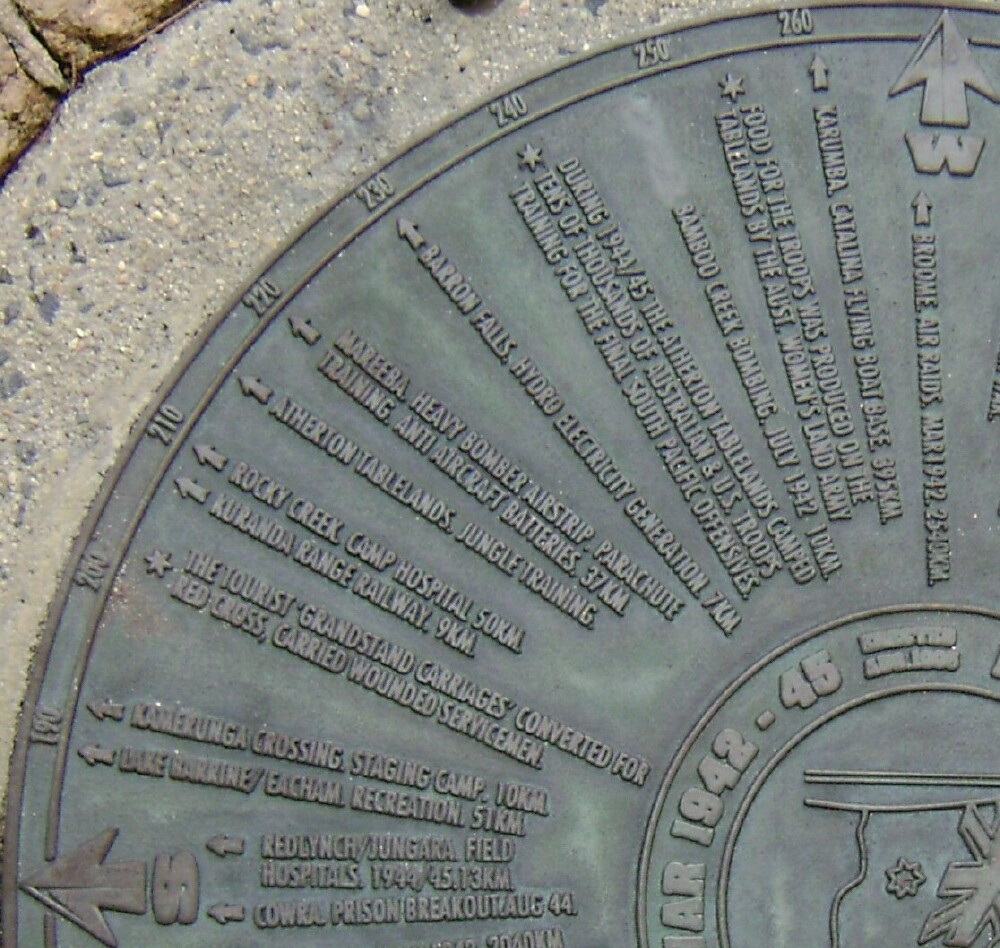
|
183 WEST REDLYNCH/JUNGARA FIELD HOSPITALS 1944/45 13KM Reputed to be the largest 'field' hospital in the Paciic, it was built at Redlynch in late 1943 ... it comprised 124 prefabricated buildings of considerable size and had sewerage, power and water from Crystal Cascades ... a siding on the Kuranda Range Railway at Jungara was used to shunt Red Cross carriages going to and from the airfields on the Tablelands ... the original Redlynch School was taken over as the administration centre x x 189’ WEST LAKE BARRINE/EACHAM RECREATION 51KM The crater lakes were a very popular spot for the troops aften their arduous jungle training, and on many occasions large numbers could be seen route marching along the roads heading there for a swim x x 192 WEST KAMERUNGA CROSSING STAGING CAMP 10KM On the banks of the Barron River, this very large staging camp operated for three years, housing tens of thousands of troops on their way to the war, just for a few nights ... it comprised of hundreds of six man tents, six kitchens and two prefab mess halls that could feed one thousand men at a sitting x x *** THE TOURIST "GRANDSTAND CARRIAGES" CONVERTED FOR RED CROSS CARRIED WOUNDED SERVICEMEN Just before the war, the railways had built four new carriages to enhance the scenic rail experience ... the tiered seats ran front to back and they had larger than usual windows ... so when they looked for the best carriages to convert for stretcher cases, these were identified ... they were gutted and refitted ... but sadly, after the war, no one remembered, so they were refurbished again as ordinary carriages ... I located them finally, and bought them for Destination Projects many years later and perhaps they are still in use x x 207 WEST KURANDA RANGE RAILWAY 9KM Restrictions on the Kuranda Range Railway were forgotten during the war ... so heavy was the traffic, getting troops back and forth from all the camps and airnelds, that during one twenty-four-hour period, fourty-three trains made the journey ... it was common for two fully loaded trains to leave close to each other, then on reaching Kuranda, they would be coupled together so one engine could pull it on to its destination ... the other engine would return to Cairns for the next job ... the evacuation plan for Cairns civilians was for everyone to get to the station, board a waiting train, which would park in a tunnel on the range until the air raids finished ... or so it is said x x 210 WEST ROCKY CREEK CAMP HOSPITAL 50KM From 1942 to 1946, a massive hospital operated at Rocky Creek, on the highway between Mareeba and Atherton ... two twelve-hundred bed hospitals, supplemented by cook houses, messes, staff accommodation (many under canvas), and everything that was needed to look after the thousands of wounded being brought back from New Guinea and the Pacific ... a very fine Memorial Park is located on the site and everyone should visit it (click here for more details) x x 216 WEST ATHERTON TABLELANDS JUNGLE TRAINING The area around Malanda and Ravenshoe were considered particularly suitable for jungle training, and many Australians recall their encounters with leeches, wait-a-whiles, stinging trees, snakes and spiders ... many of them were returning from a long time in the Middle East, and their experiences in the desert would hardly have prepared them for the jungles of New Guinea x x 220 WEST MAREEBA HEAVY BOMBER AIRSTRIP PARASHUTE TRAINING ANTI AIRCRAFT BATTERIES 37KM This very large airfield was the main staging point for planes headed on to New Guinea and the islands ... it had search light units, anti aircraft units, and all sorts of support facilities too numerous to mention here ... at one point, it was operated by two thousand Army and two hundred Air Force personnel x x 230 WEST BARRON FALLS HYDRO ELECTRICITY GENERATION 7KM Built before the war, this hydro-electricity generating plant is still housed in a cave below the Barron Falls ... although it was abandoned long ago, the machines can still be seen by the very adventurous ... no power networks in those days, and most of the regions power came from this source, supplemented by a gas powered station in McLeod Street x x *** DURING 1944/45 THE ATHERTON TABLELANDS CAMPED TENS OF THOUSANDS OF AUSTRALIAN AND US TROOPS TRAINING FOR THE FINAL SOUTH PACIFIC OFFENSIVES Probably the most effective kick start the tourist industry could ever have ... tens of thousands of troops getting a preview of the area ... many have returned in subsequent years and there might still be some who can appreciate this memorial x x 248 WEST BAMBOO CREEK BOMBING JULY 1942 10KM In July 1942, a Japanese plane, assumed to come from the Solomon Islands, did drop a bomb at Miallo, up near Rocky Point ... it is thought that it was looking for the Cairns airstrip ... no one was hurt, but some chooks were decapitated and there was a large crater in a farmer’s yard ... a school kid took some bomb casing fragments to school and it is believed they are still in a museum up there somewhere x x *** FOOD FOR THE TROOPS WAS PRODUCED ON THE TABLELANDS BY THE AUST WOMEN'S LAND ARMY Women were recruited to fill the vacancies caused by the enlistment of many farm workers ... they went where they were sent and lived in barracks or were billeted out ... issued with overalls and other work gear, they wore an Army type uniform when not working ... the girls were trained to drive tractors and trucks, and without them, feeding the thousands of troops here and in the Pacific would have been an impossible task x x 261 WEST KARUMBA CATALINA FLYING BOAT BASE 395KM Most of the 'Cats' were based in Cairns and Bowen, but in 1943 it was decided to station a squadron at Kurumba, in the Gulf, to better reach the enemy bases around the Solomon Islands ... remarkably, there were already facilities there for flying boats, as Qantas stopped there for fuel for the Sunderland plane they operated between Sydney and London ... with excellent range for reconnaissance, the all time record was set when a Cat from Caims stayed in the air for thirty-eight hours and twenty-five minutes x x 269 WEST BROOME AIR RAIDS MAR 1942 2540KM |
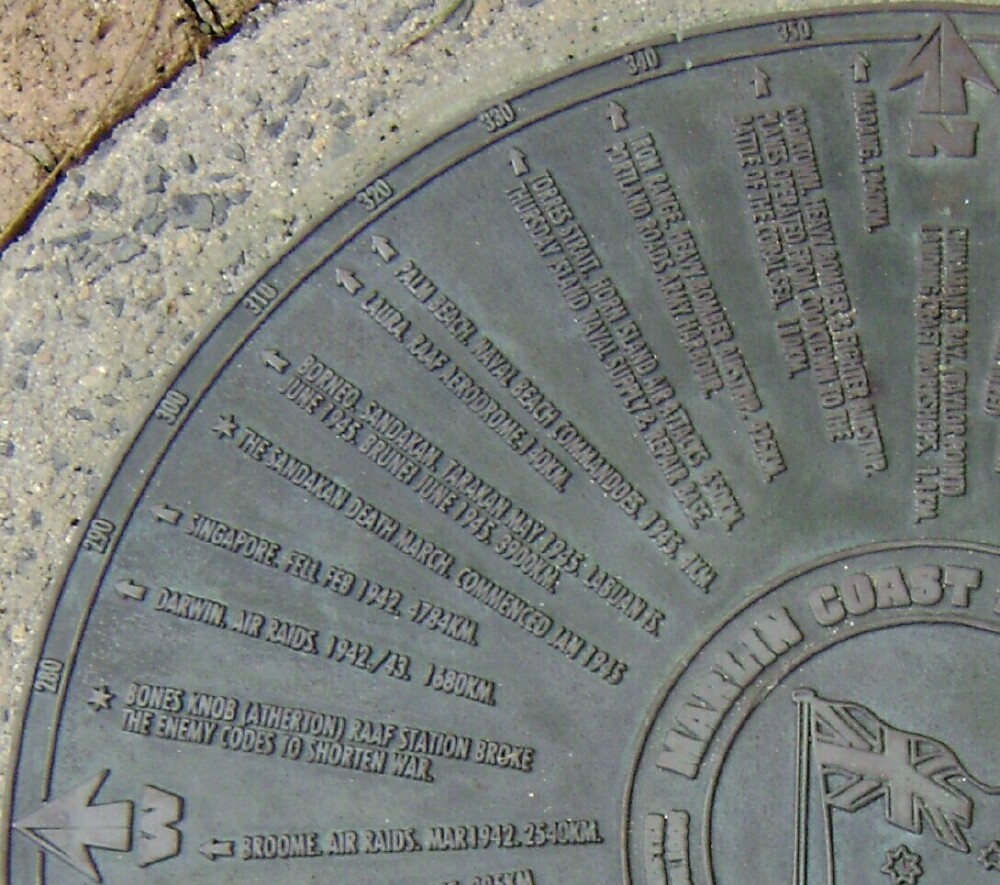
|
*** BONES KNOB (ATHERTON) RAAF STATION BROKE THE ENEMY CODES TO SHORTEN WAR Bones Knob, just up the hill to the north of Tolga, had a radar station ... but more importantly, it housed a Special RAAF Wireless Unit, which intercepted radio traffic between enemy forces ... it is recorded that it was their work in breaking enemy codes, which helped to shorten the war x x 287 NORTH DARWIN AIR RAIDS 1942/43 1680KM On 19 February 1942, 188 planes were launched against Darwin whose harbour was full of ships ... a second raid of 54 bombers was launched two hours later on the same day ... the raids on 19 February were the first two of sixty-four raids against the Darwin area and its nearby airhelds, which bore the brunt of Japanese attacks on mainland Australia x x 294 NORTH SINGAPORE FELL FEB 1942 4784KM There have been a million words written and said about the fall of Singapore, but we must always remember the seven hundred Australians who died trying to defend the town and the Malayan peninsular x x *** THE SANDAKAN DEATH MARCH COMMENCED JAN 1945 2345 men deliberately murdered by the Japanese while our troops were here, in Cairns, training for the invasion of Borneo ... the fact that it was not prevented is often put down to the American Forces refusing to supply ships to liberate these prisoners before the march began x x 307 NORTH BORNEO SANDAKAN TARAKAN MAY 1945 LABUAN IS JUNE 1945 BRUNEI JUNE 1945 3900KM The invasion of Borneo was an entirely Australian project ... to help explain its extent, the final assault on Balikpapan involved 33,000 troops, all of whom would have been stationed in this area prior to the invasion x x 315 NORTH LAURA RAAF AERODROME 140KM Significant airlields were constructed in several Cape York locations because they put our bombers closer to targets like Rabual ... there was great concern that the Japanese might occupy Cape York, with its isolation, plenty of channels through the reef for support shipping, and plenty of food ... the Australians recognised that invading Japanese could live well off all the cattle that were bred in that region, there for the taking x x 319 NORTH PALM BEACH NAVAL BEACH COMMANDOES 1945 4KM There were two Naval Commando groups on the Marlin Coast ... one was camped at Palm Cove and the other at Deep Creek, about where the Paradise Palms golf clubhouse is sitting ... always a sore point with my father, Commanding Officer of the second group, was that the Japanese should build a clubhouse on his old headquarters site x x 329 NORTH TORRES STRAIT HORN ISLAND AIR ATTACKS 650KM THURSDAY ISLAND NAVAL SUPPLY AND REPAIR BASE The communications facilities and airfields in the Torres Straits were under heavy fighter and bomber attack during the war and stories abound of 'dog fights' between Zeros and Lockheed Lightenings over the islands x x 337 NORTH IRON RANGE HEAVY BOMBER AIRSTRIP 425KM PORTLAND ROADS ARMY HARBOUR The airstrip at Iron Range did exist before the war, when it was used by two wing commercial aircraft ... it was the best available site for long-range bombers to fly to Rabaul and return without refueling x x 347 NORTH COOKTOWN HEAVY BOMBER AND FIGHTER AIRSTRIP PLANES OPERATED FROM COOKTOWN TO THE BATTLE OF THE CORAL SEA 110KM Planes involved in the Battle of the Coral Sea were actually stationed at Laura, a distance inland, but used Cooktown as an emergency strip ... a memorable story involved Army personnel traveling to Cooktown on the Laura railway on leave in the open topped carriages ... popular sport was shooting wild pigs from the carriages, then getting the driver to stop the train so they could collect the carcasses x x 355 NORTH MADANG 1260KM A memorial stands at Madang, dedicated to the thirty-six coast watchers who died passing on intelligence to the Australian Forces during the war ... these very brave men, assisted by the natives, did an exceptional job, and it is appropriate that they are remembered here at Trinity Beach through the naming of Coastwatcher Park, where this memorial was previously located |
|
Reference material used to compile the information
on this memorial plaque is:- #1 - "I Didn't Know That" by Vera Bradley Cairns ... Cairns and Districts ... Tully to Cape York ... 1939 to 1946 ... Service Personnel and Civilians (click here for more details) #2 - The Times "Atlas of the Second World War" (available in most libraries) #3 - The Australian War Memorial web site #4 - Personal observations and discussions with eye witnesses #5 - My father, Lt Cdr Ron McKauge DSC VRD OBE (click here for more details) Gordon McKauge ... Trinity Beach Monday 25th April 2005 |
. . |
Should you require it, click HERE to download a free version of the PowerPoint Viewer |
|
Marlin Coast War Memorial . NOTE - 5.34Mb download .
|
Louis and Clevey Jones and their son Roderick . |